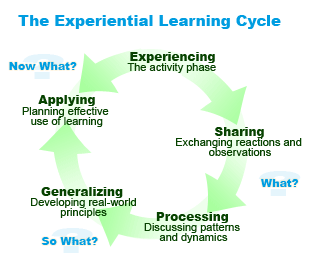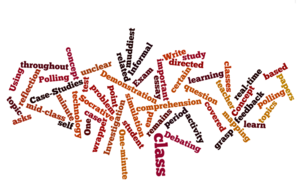Course:CTLT Course Design Intensive December 2014/Formative Assessments
Situational Factors
Introduction – 3 minutes
We are the breaking the fourth wall to speak candidly about our process as facilitators with (you) the participants, because of course, we are modelling the concepts that we are introducing.
CTLT Formative Assessment Form
Please fill in the formative assessment form. You have 5 minutes
- CTLT Feedback Form - Situational Factors - online form (open, edit, save, print from your computer)
- CTLT Feedback Form - Situational Factors - print form
- Situational Factors — Jessica, Joseph
- The best part about today’s session about Situational Factors for me was……
- because…..
- because…..
- If I could change or add anything to today’s session I would…..
- because…..
- because…..
- I would like more…..
- because ..
- because ..
- I would like less…..
- because…..
- because…..
- I would also like to say/observe/suggest…
Formative Assessment Definition
Please read this definition. You will also receive a hard-copy. Formative Assessment and Summative Assessment
The goal of formative assessment is to monitor student learning to provide ongoing feedback that can be used by instructors to improve their teaching and by students to improve their learning. More specifically, formative assessments:
- Help students identify their strengths and weaknesses and target areas that need work
- Help faculty recognize where students are struggling and address problems immediately
Formative assessments are generally low stakes, which means that they have low or no point value. Examples of formative assessments include asking students to:
- Draw a concept map in class to represent their understanding of a topic
- Submit one or two sentences identifying the main point of a lecture
- Turn in a research proposal for early feedback
Source: http://www.cmu.edu/teaching/assessment/basics/formative-summative.html
- We will also pass out the CDI Formative Assessment forms (two copies each). One to fill in and return to us. The other to retain with the definition.
- Participants fill in the Formative Assessment form and hand those in us. – 5 minutes
- Participants review the Formative Assessment that they are keeping - and make notes on it mapping the definition to the form. – 2 minutes
We will discuss their findings in a later session on Formative Assessment. The timing is because we will have a debriefing session about this as part of the formative assessment session after another session.
Course Design Intensive December 2014
Developing Course Goals and Learning Objectives
These questions will be presented in an online quiz Room 79129.
- What are the advantages of using the DACUM approach to course design?
- What are the disadvantages of using the DACUM approach to course design?
- What did you find most useful about this session on articulating course goals and learning objectives?
- If you could re-design this session, what would you do differently?
- I would also like to say/observe/suggest…
We will display the responses on the screen and Marie and Roselynn will discuss how they would use that information to respond to the learners and to modify their course if necessary.
- Formative Assessment online form (open, edit, save, print from your computer)
- Formative Assessment printed form
Course Design Intensive December 2014
Backward Design and Assessment
Review outcomes from Session One Formative Assessment.
Mapping Definition to the questions in the Course Design Intensive form.
Metacognition Exercise - blog entry
Consider this picture.

Can you see how this applies to what you are doing before our sessions and while we are together?
Please reply with a comment about our session on Backward Design and Assessment.
Copy the questions in the blue section below and paste them into a reply to this post (click the button at the bottom). Then add your responses. Please do not look at the other responses until after you have done your own.
Highlights / Metacognition
- What did you think was the most valuable thing that happened for you this morning?
- What did you learn from that?
- What will you do with that knowledge?
A few more questions?
- Now that we've had our session on Backward Design and Assessment, what do you want to know?
- What could we have done better?
If you spot a question from someone else and you can answer it - please do.
Course Design Intensive December 2014
Learning Activities

Ask participants to answer these three questions in an online socrative
- Name a learning activity that you can use as a formative assessment.
- How would your students be informed by this learning activity?
- How would you (instructor) use the outcomes of the formative assessment?
We will have already introduced them to this definition of Formative Assessment on Monday. I’ll remind them of that.
- Formative Assessment
The goal of formative assessment is to monitor student learning to provide ongoing feedback that can be used by instructors to improve their teaching and by students to improve their learning. More specifically, formative assessments:
- Help students identify their strengths and weaknesses and target areas that need work
- Help faculty recognize where students are struggling and address problems immediately
Formative assessments are generally low stakes, which means that they have low or no point value.
The steps
- Answer questions online. 10 minutes (Two separate quizzes Question 1 – 4 minute deadline, then remaining time second quiz with the last two questions). While they are doing questions 2 and 3, I would will convert the answers to question 1 into a Wordle.
- Display the Wordle on the projector (and add it to the CTLT wiki page later). At this point we would also give them a paper copy of the three questions and the definition.
- Luisa, Stefania, and Emily comment on what you see in the Wordle. (5 minutes). You would address these points.
- How you would take the information in the Wordle and use that to provide formative feedback to the participants.
- How you would use the information in the Wordle to inform your future teaching in this CTLT Course Design Intensive course.
- I will publish the answers to all the questions online on Wednesday night or Thursday.
Course Design Intensive December 2014
Rubrics and Evaluation
- Responses to the Formative Assessment Question
How has your thinking about Rubrics changed as a result of this morning's session?
Individual responses are separated by blank lines
Yes, I had originally only used these for questions and assignments which I felt had clear and straightforward answers. After this session I can see how to use a rubric for a more open ended type of question (psuedorubric).
Thinking about a rubric as measuring whether the student is achieving and demonstrating the competencies of their discipline is helpful, and I have a better understanding of how evalulation ties into the other two components of learning.
I used the exercise time to review my existing rubic, and identified three challenges I was aware of: what to do when the grade is below a C (and perhpas why this may have happened); what to do when marks seem to be a bit too high or low overall; and what to do in when the blocks in the rubric are not sufficiently differentiated.
My thinking about a rubric is has not really changed (e.g., as a tool for fair assessment, as feedback for students), but my thinking in terms of creating rubrics has changed (e.g., how to create a pseudo rubric, what to consider, how to translate Bloom's taxonomy of learning into the rubric).
Demonstrates its flexibility in designing for a domain or discipline and assessment preference.
The exact rubrics is very important to the student
No, but I understand different approaches and ways to use them.
The example of a pseudo rubric has helped me with something I have struggled with for a while. I have been using rubrics as a way of making consistent the grading process, as well as tools for student learning. However, I hadn't yet figured out how to make the structure flexible for open-ended competency based assignments.
It seems simple but the significance of the even number of levels had not occured to me. I also have extrapolated that to thinking about the possible points assigned in the categories. I know from my expereince using rubrics that I often choose the middle point.
Prior to this morning, I didn't have a good understanding of how to use a rubric, in particular for the type of course I'm designing (which will have no summative assessment, just formative assessment). With the introduction of a psuedo-rubric, I can now see how I might use one to inform both the students' learning and the formative assessment of that learning.
I'll give some more thought to if/when to give rubrics to students beforehand. I like the pseudo rubric idea and linking it back to Blooms. I find Joseph's tactic of having students prepare for 6 exam questions and then writing 2 (chosen by Joseph) brilliant. It encourages a lot of learning without generating a lot of marking!
Have a better understanding of how to design rubrics so that they enhance learning objectives by providing students with clear guidance/feedback about assessment criteria, i.e. so that a students know why a "good answer" is "good", and why a "bad answer" is "bad". The distinction between a narrow-focus "rubric" and a broad-focus "pseudo-rubric" was especially helpful.
very informative and useful session- I knew about the rubrics but did not felt cofident enough to develop one- the provided tools and information definitely helped to pass that hurdle
It hasn't because I have used rubrics extensively
I think the big thing for me was about linking rubrics to learning objectives and learning activities. Not only does there need to be alignment between these three things, but they can actually be the same thing....with the way that they are carried out being slightly differently articulated.
I wasn't aware of the "pseudo-rubric" that can be applied to assignments where higher level competencies are expected of the students. I really liked the modification of Bloom's taxonomy into the disciplinary language in the example that Joseph provided. I can really see how to build a rubric with a more flexible structure into my graduate level course now.
I have a lot of work to do to develop rubrics that mesh with my work for the previous two days of the workshop...ensuring everything is aligned.
They can be used as a feedback tool for the students rather than only as a guide for assessors.
Rubrics should be concentrated to objectives, and it is a good choice to let the students know them clearly.
It can be integrated with the bloom's Taxonomy and exams appling it can be more challenging with proper design of rubrics.
How to connect the course goals and bloom taxonmy with the structure of the rubrics
Yes,I regarded Rubrics just as a set of rules before the session.
Now I know how to formulate the Rubrics according to some certain rules.
I am able to look into assessment criteria, break theae down into students' level of achievement, while linking learning outcomes.
Course Design Intensive December 2014